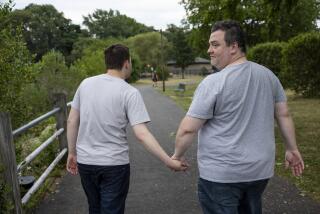Infants’ Brain Waves May Indicate Potential Learning Disorder, Psychologist Says : Intelligence: Computer tests of newborns may detect disability before it’s too late to remedy problem.
- Share via
CARBONDALE, Ill. — Parents who count their newborn’s fingers and toes soon might be checking something else: the baby’s brain waves.
A Southern Illinois University psychologist says that after nearly 20 years of research, it appears an infant’s brain waves can reveal whether the child has a learning disorder. That could be good news for about 700,000 infants born annually who are at risk of developing learning problems.
“Our hope is if we can identify these kids at birth, we can start intervening shortly after, eight or nine years earlier than it otherwise would be,” said Dennis Molfese, who has been directing the study with his wife, Victoria.
“If that’s the case, then we can get sort of a running start on not only teaching the kids strategies to circumvent the disability, but perhaps even to do away with the disability altogether,” he said.
Such lofty ambitions didn’t concern 5-year-old Robert Jones, his sandy-blond hair covered with electrodes. He sat still recently while listening to computer-generated beeps and boops, seeming more intrigued by a picture book before him.
“He was a preemie baby and he’s been involved in it since then,” said his mother, Margaret Jones. “He enjoys it. This year, he just wanted to do it, so I let him.”
The research began in 1977 with 32 babies who were tracked for four years, including the Molfeses’ own son, David. The infants were monitored while listening to noises. The premise is that their brain waves show how well they can discriminate between speech sounds, which is a key step to learning language.
Since 1986, armed with $1 million in grants from the National Institutes of Health, the Molfeses have been following 400 newborns. They are finding that standardized tests have confirmed their predictions in 100% of those tested between birth and 3 years of age.
The brain wave of a baby who may be learning disabled shows a large trough in areas that are shallower in infants with average or superior capabilities. And it all happens in the blink of an eye: A brain wave lasts only about seven-tenths of a second and packs a punch of 5- to 10-millionths of a volt.
Molfese said the test also reveals children who may have larger vocabularies, understand directions and complex sentences better and have an advantage at mathematics and puzzle solving.
“I think it’s the most important cutting-edge research in predicting language or learning problems in newborns,” said Virginia Berninger, a psychologist specializing in early reading disabilities at the University of Washington in Seattle.
William Greenough, a University of Illinois psychologist studying the effect of the environment on brain development, was more sparing with his praise but said Molfese’s work appeared significant.
“It certainly seems like it would be a reasonable thing to do,” Greenough said. “It sounds like a fairly major breakthrough.”
A baby with dipping brain waves isn’t condemned to academic mediocrity, Molfese said. Environment and family also play a major role in a child’s intellectual development, and remedies such as special reading programs are available, he added.
Early intervention will be the next phase of Molfese’s research. He said children with learning disabilities usually aren’t detected until the third grade, and then it might be too late.
“I guess I’m a firm believer that you can intervene and change things,” Molfese said.
He hopes when his study is finished in 1 1/2 years to persuade doctors to use his test to screen newborns.






